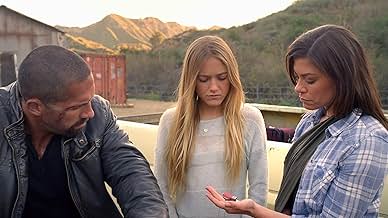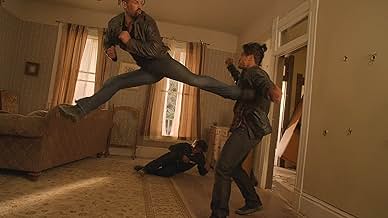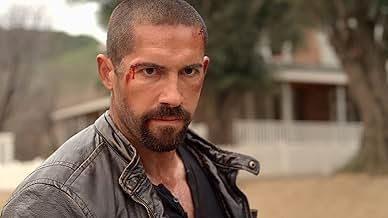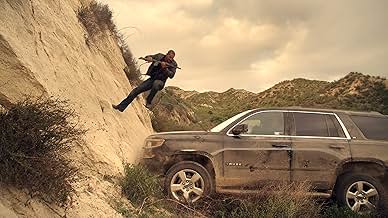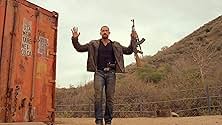VALUTAZIONE IMDb
5,1/10
5832
LA TUA VALUTAZIONE
In Messico un narcotrafficante sospetta che il suo contatto stia rubando della merce e così gli rapisce la figliastra. A salvarla, lasciando una scia di sangue, sarà lo zio, un ex soldato.In Messico un narcotrafficante sospetta che il suo contatto stia rubando della merce e così gli rapisce la figliastra. A salvarla, lasciando una scia di sangue, sarà lo zio, un ex soldato.In Messico un narcotrafficante sospetta che il suo contatto stia rubando della merce e così gli rapisce la figliastra. A salvarla, lasciando una scia di sangue, sarà lo zio, un ex soldato.
Trama
Lo sapevi?
- QuizThe Czech Mixed Martial Artist Filip Dusilka played a small role of bodyguard in Lobo's penthouse.
- BlooperAt 38 minutes, the two abandoned vehicles are in much different positions than they were when they stopped and everyone got out.
- Colonne sonoreParty Redux
Performed by Nathaniel Dawkins
Music by Nathaniel Dawkins, Tom Erba, Stephen Edwards
Recensione in evidenza
"Close Range" boasts excellent martial arts choreography. The hand-to-hand fights earn solid A grades, while the knife fights earn middling Bs. Production values are adequate for the budget and genre, although far too much reliance is placed on jiggly-cam shots. Make-up effects are of uneven quality. The script is a mishmash of overused tropes with just enough clever one-liners to consider a clemency plea when they go to lynch the writer. A climatic paean to Sergio Leone is fairly good – until they inexplicably shift POV from third-person to first with a memory flash. With no character arcs, moral or coherent theme, the actors don't have much to do except try to kill one another. Several characters are dispatched for no particular reason other than dramatic effect. Scott Adkins does an adequate job as the taciturn loner antihero and handles the action scenes admirably, but deserves a better script.
Where the movie fails is in the gunfights, which comprise a large portion of the running time. We should establish some basic rules for gunfight choreographers and movie characters who find themselves in gunfights.
1. If you have a limited amount of ammunition, you might not want to use it all laying down suppressive fire. Save your bullets until you have a target in sight.
2. If you've taken cover in a dimly lit house and the heavily armed bad guys are outside in the bright sunlight, you have a huge tactical advantage because you can see them much more easily than they can see you. However, you sacrifice that advantage if you stand by the window and stick the barrel of your weapon outside, because now they can see you and you may also have the sun in your eyes. A better strategy is to stand back away from the window and fire. If the bad guy is fifty yards away, you don't gain much advantage by moving to where he's only forty-nine yards away, but you sacrifice a considerable advantage.
3. If your weapon fires really big bullets that are the length of a man's finger and have tapered casings, they probably pack a bit of a punch and go through things like walls and the sheet metal used in automobile bodies. You're probably better off trying to fire through whatever the bad guy is hiding behind than firing overhead and hoping the bullet changes course directly above him.
4. Those little metal things over the barrel and above the breech are called sights. You stand a much better chance of hitting your target if you use them.
5. If you've seen "Zombieland," you know the advantage to a double-tap, but the incremental advantage drops dramatically. When you have a limited amount of ammunition, there isn't much advantage to putting five high-power rifle rounds through somebody's chest, as opposed to only one or two.
Other than the climatic scene, the gunfight choreography was painfully amateurish and largely nonsensical. The only purpose seemed to be to empty the weapons so the characters would need to engage in hand-to-hand combat. Initially, the characters seemed oblivious to the notion that bullets can go through things, even after a character is hit. Later, they did little except fire through walls, floors and protective gear.
The movie is a series of well choreographed fight scenes admirably executed by Scott Adkins and his opponents, linked together by a flimsy excuse for a plot. Fortunately, the fight scenes are worth the price of admission.
Where the movie fails is in the gunfights, which comprise a large portion of the running time. We should establish some basic rules for gunfight choreographers and movie characters who find themselves in gunfights.
1. If you have a limited amount of ammunition, you might not want to use it all laying down suppressive fire. Save your bullets until you have a target in sight.
2. If you've taken cover in a dimly lit house and the heavily armed bad guys are outside in the bright sunlight, you have a huge tactical advantage because you can see them much more easily than they can see you. However, you sacrifice that advantage if you stand by the window and stick the barrel of your weapon outside, because now they can see you and you may also have the sun in your eyes. A better strategy is to stand back away from the window and fire. If the bad guy is fifty yards away, you don't gain much advantage by moving to where he's only forty-nine yards away, but you sacrifice a considerable advantage.
3. If your weapon fires really big bullets that are the length of a man's finger and have tapered casings, they probably pack a bit of a punch and go through things like walls and the sheet metal used in automobile bodies. You're probably better off trying to fire through whatever the bad guy is hiding behind than firing overhead and hoping the bullet changes course directly above him.
4. Those little metal things over the barrel and above the breech are called sights. You stand a much better chance of hitting your target if you use them.
5. If you've seen "Zombieland," you know the advantage to a double-tap, but the incremental advantage drops dramatically. When you have a limited amount of ammunition, there isn't much advantage to putting five high-power rifle rounds through somebody's chest, as opposed to only one or two.
Other than the climatic scene, the gunfight choreography was painfully amateurish and largely nonsensical. The only purpose seemed to be to empty the weapons so the characters would need to engage in hand-to-hand combat. Initially, the characters seemed oblivious to the notion that bullets can go through things, even after a character is hit. Later, they did little except fire through walls, floors and protective gear.
The movie is a series of well choreographed fight scenes admirably executed by Scott Adkins and his opponents, linked together by a flimsy excuse for a plot. Fortunately, the fight scenes are worth the price of admission.
- ginocox-206-336968
- 25 dic 2015
- Permalink
I più visti
Accedi per valutare e creare un elenco di titoli salvati per ottenere consigli personalizzati
- How long is Close Range?Powered by Alexa
Dettagli
Botteghino
- Budget
- 3.000.000 USD (previsto)
- Lordo in tutto il mondo
- 248.978 USD
- Tempo di esecuzione1 ora 20 minuti
- Colore
- Proporzioni
- 1.78 : 1
Contribuisci a questa pagina
Suggerisci una modifica o aggiungi i contenuti mancanti

Divario superiore
By what name was Close Range - Vi ucciderà tutti (2015) officially released in India in English?
Rispondi



